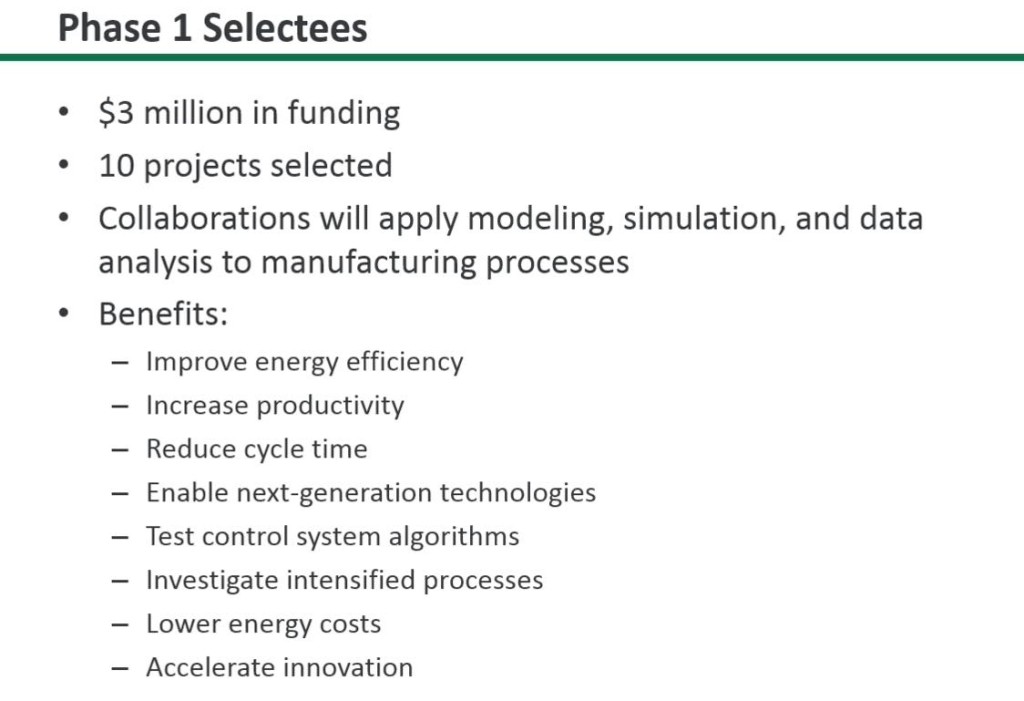 Today U.S. Department of Energy’s announced 10 new High Performance Computing for Manufacturing (HPC4Mfg) projects. Under the HPC4Mfg program, National laboratory experts in advanced modeling, simulation and data analysis collaborate with industrial partners on project teams to address manufacturing challenges that will aid in decision making, optimize processes and design, improve quality, predict performance and failure, quicken or eliminate testing, and/or shorten the time of adoption of new technologies.
Today U.S. Department of Energy’s announced 10 new High Performance Computing for Manufacturing (HPC4Mfg) projects. Under the HPC4Mfg program, National laboratory experts in advanced modeling, simulation and data analysis collaborate with industrial partners on project teams to address manufacturing challenges that will aid in decision making, optimize processes and design, improve quality, predict performance and failure, quicken or eliminate testing, and/or shorten the time of adoption of new technologies.
New industry partners for the program will receive $3 million in funding through this national laboratory-run program that will address key challenges facing U.S. manufacturing. These collaborations will apply modeling, simulation, and data analysis to industrial processes and materials to lower production costs and bring new products to market more quickly.
At the announcement event, David Danielson, Assistant Secretary for Energy Efficiency and Renewable Energy, highlighted the selection of the following 10 Projects during an online media presentation on February 17, 2016, describing the program and the awardees.Under the formal governance model, these projects underwent a concept paper review, followed by a full proposal review, prior to selection. These projects will now enter into CRADA agreements supported by ~ $300k of Advanced Manufacturing Office (AMO) funding and at least $60K of in-kind and/or cash contribution from the industry partner.
“The Energy Department wants to make sure that the clean energy technologies and efficient manufacturing that defines the next decades is invented and built right here at home,” said David Danielson. “The HPC4Mfg Program couples leading clean energy technology companies with the world-class computing tools and expertise at our national labs to drive down the cost of energy-efficient materials and manufacturing processes, making the U.S. more globally competitive.”

Danielson also announced that AMO is making another $3 million available for qualified industry partners to participate in a new round of HPC4Mfg proposals, to be announced in the coming month.
The selected projects include:
- GLOBALFOUNDRIES will collaborate with LBNL to optimize the design of transistors under a project entitled: “Computation Design and Optimization of Ultra-Low Power Device Architectures.”
- The Lightweight Innovations for Tomorrow Consortium in Michigan will partner with LLNL to develop, implement and validate a defect physics-based model to predict mechanical properties of Al-Li forged alloy, under a project entitled: “Integrated Computational Materials Engineering Tools for Optimizing Strength of Forged Al-Li Turbine Blades for Aircraft Engines.”
- ZoomEssence, Inc. of Kentucky will partner with LLNL to optimize the design of a new drying method using HPC simulations of dryer physics, under a project entitled: “High Performance Computing Analysis for Energy Reduction of Industry Spray Drying Technology.”
- United Technologies Research Center, located in East Hartford, Connecticut, will partner with ORNL and LLNL to develop and deploy simulation tools that predict the material microstructure during the additive manufacturing process to ensure that critical aircraft parts meet design specifications for strength and fatigue resistance, under a project entitled: “Integrated Predictive Tools for Customizing Microstructure and Material Properties of Additively Manufactured Aerospace Components.”
- Procter & Gamble of Ohio will partner with LLNL to reduce paper pulp in products by 20 percent, which could result in significant cost and energy savings in one of the most energy intensive industries, under a project entitled: “Highly-Scalable Multi-Scale FEA Simulation for Efficient Paper Fiber Structure.”
- General Electric (GE), New York, will partner with ORNL to assist in the local control of melt pool and microstructure in additive manufactured parts, under a project entitled: “Process Map for Tailoring Microstructure in Laser Powder Bed Fusion Manufacturing (LPBFAM) Process.”
- In a separate project, GE will partner with ORNL and LLNL to improve the efficiency and component life of aircraft engines through design optimization, under a project entitled: “Massively Parallel Multi-Physics Multi-Scale Large Eddy Simulations of a Fully Integrated Aircraft Engine Combustor and High Pressure Vane.”
- PPG Industries, Inc. of North Carolina will partner with LLNL to model thermo-mechanical stresses involved in forming and solidifying glass fibers to understand fracture-failures mechanisms to significantly reduce waste, under a project entitled: “Numerical Simulation of Fiber Glass Drawing Process via a Multiple-Tip Bushing.”
- In a separate project, PPG Industries, Inc. of Pennsylvania will partner with LLNL to develop a reduced computational fluid dynamics (CFD) model of a glass furnace to make informed line adjustments in hours in near real-time, under the title: “Development of Reduced Glass Furnace Model to Optimize Process Operation.”
- The AweSim program at the Ohio Supercomputer Center (OSC) and the Edison Welding Institute (EWI) will partner with ORNL to deploy cloud-based advanced welding simulation tool for broad industry use, under a project entitled: “Weld Predictor App.”



